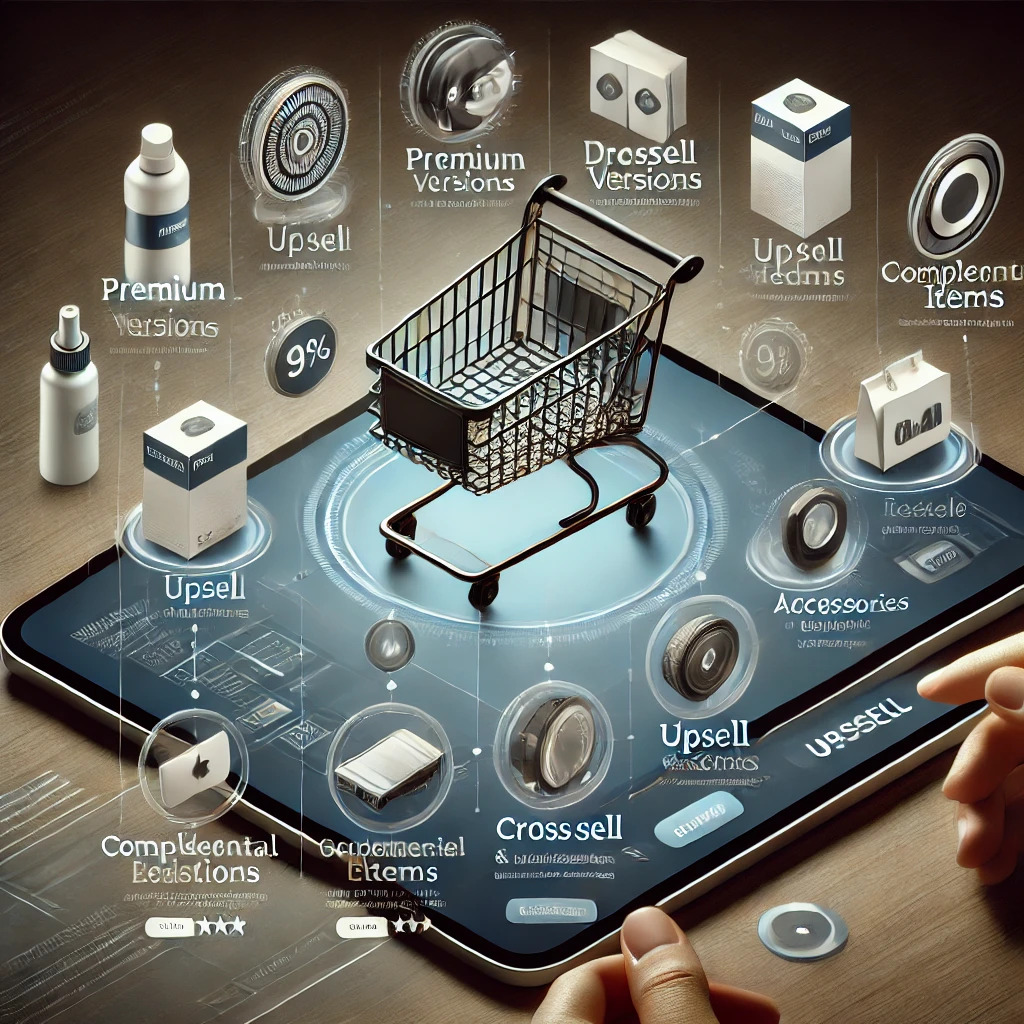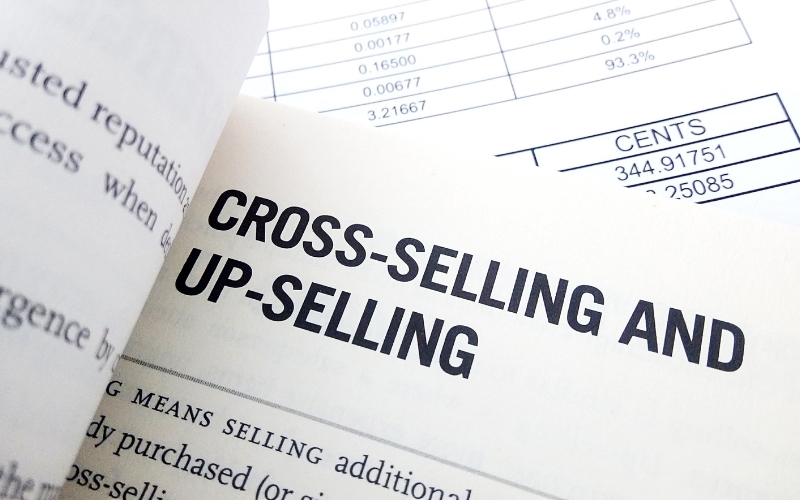
In the competitive world of e-commerce, businesses are constantly looking for strategies to enhance revenue and improve customer satisfaction. Upselling and cross-selling are two key techniques that have proven to be extremely effective in achieving these goals. While they share the same ultimate objective—encouraging customers to spend more—they differ in their approach. Understanding the distinctions between these two strategies is essential for businesses looking to optimize their sales process, improve the customer experience, and increase overall profitability.
Understanding the Difference Between Upselling and Cross-Selling

When it comes to increasing revenue and improving customer satisfaction in e-commerce, upselling and cross-selling are two powerful techniques. Both strategies aim to encourage customers to spend more, but they operate in slightly different ways. Understanding the distinction between upselling and cross-selling is crucial for businesses looking to optimize their sales process and enhance the shopping experience.
Upselling involves persuading a customer to purchase a more expensive version of a product they’re already considering. The goal is to get the customer to upgrade to a higher-tier product with better features, additional benefits, or enhanced quality. For example, if a customer is browsing a basic laptop, an upsell might involve suggesting a premium model with better specifications. The idea behind upselling is that customers are already willing to make a purchase, so offering them a higher-priced item that adds more value can increase the overall order value.
On the other hand, cross-selling focuses on encouraging customers to buy additional products that complement their original purchase. Instead of offering an upgraded version of the same item, cross-selling introduces new products that enhance or work alongside the customer’s initial choice. For instance, if a customer is purchasing a smartphone, cross-selling might involve suggesting a phone case, screen protector, or Bluetooth headphones. The goal of cross-selling is to increase the total number of items in the cart by offering relevant products that meet the customer’s needs.
While both upselling and cross-selling aim to boost sales, they differ in approach. Upselling typically involves increasing the price of a single item, while cross-selling is about expanding the number of items in the customer’s order. Both techniques can be extremely effective when used together, providing a more comprehensive and satisfying shopping experience for the customer. However, it’s important for e-commerce businesses to strike a balance and ensure the recommendations are truly valuable to the customer. Overdoing either strategy can come across as pushy or irrelevant, potentially leading to cart abandonment.
Why Upselling and Cross-Selling Are Essential for E-Commerce Success

In the highly competitive world of e-commerce, businesses are constantly looking for ways to drive revenue and improve the customer experience. Upselling and cross-selling are two powerful strategies that have proven to be essential for achieving both of these goals. These techniques not only help businesses increase their average order value but also enhance customer satisfaction by providing more personalized shopping experiences.
Upselling and cross-selling are essential for driving revenue growth in e-commerce. By offering customers higher-priced or complementary items, businesses can increase the total value of each transaction. Upselling encourages customers to upgrade to a premium product, which often comes with higher profit margins, while cross-selling introduces additional products that may not have been considered initially but provide added value. This dual approach ensures that each customer spends more during their visit, leading to higher sales without requiring a significant increase in traffic.
Another significant benefit of upselling and cross-selling is the positive impact on the customer experience. When done correctly, these strategies don’t just push additional products on customers—they offer relevant recommendations that enhance the customer’s shopping experience. For example, recommending a premium version of a product the customer is already interested in or suggesting complementary items based on their purchase history creates a personalized shopping environment. This personalized approach makes customers feel understood and valued, which can lead to increased customer loyalty and repeat business.
Additionally, both strategies contribute to increasing the average order value (AOV), which is a key metric for e-commerce success. By encouraging customers to purchase more expensive items or add additional products to their cart, businesses can boost the AOV without needing to increase traffic or make drastic changes to their marketing strategies. For instance, a simple upsell on a checkout page—like offering a discount on a related product—can effectively increase the value of the sale. Similarly, cross-selling can encourage customers to buy accessories or complementary products, further raising the AOV.
Effective Techniques for Upselling in E-Commerce

Upselling is a powerful strategy that can significantly boost your e-commerce sales when implemented effectively. Upselling and cross-selling work hand-in-hand, but upselling specifically focuses on encouraging customers to purchase a more expensive version of the product they’re already considering. To maximize the impact of upselling, businesses need to implement actionable techniques that create value for both the customer and the business. Here are some proven strategies for effective upselling in e-commerce:
- Offer Premium Versions of Products
One of the simplest and most effective upselling techniques is presenting customers with a premium version of the product they’re already considering. For example, if a customer is looking at a basic model of a smartphone, offer them a higher-tier version with better features, such as more storage, a better camera, or longer battery life. By highlighting the advantages and added benefits of the premium version, you can convince the customer that the higher price is justified. This technique works particularly well when the premium product is only slightly more expensive than the basic version, making it an attractive option for customers willing to upgrade for a better experience. - Showcase Product Bundles
Product bundling is another highly effective upselling strategy. By combining related products into a single package, businesses can encourage customers to purchase more while offering them a discount compared to buying each product individually. For instance, if a customer is purchasing a laptop, you can suggest a bundle that includes a laptop case, wireless mouse, and extended warranty. This not only increases the order value but also provides added convenience for the customer by offering everything they need in one package. Be sure to highlight the savings that come with the bundle to make it an irresistible offer. - Use Personalized Recommendations
Personalized recommendations are a powerful tool for upselling. By analyzing customer data—such as browsing history, previous purchases, or preferences—e-commerce businesses can suggest upsells that align with the customer’s interests. For example, if a customer is purchasing a specific brand of running shoes, recommending matching running gear like socks or a water bottle can increase the likelihood of an upsell. Personalized recommendations create a more tailored shopping experience, making the customer feel understood and valued, which can ultimately lead to higher sales. - Leverage Exit-Intent Popups
Exit-intent popups are a smart tactic for upselling when a customer is about to leave the website. These popups can present an offer for a premium version of a product or a related upgrade right before the customer exits. For example, if a customer is about to abandon their cart with a mid-range laptop, you can trigger a popup offering them a special deal on a more advanced model.
Mastering Cross-Selling: Best Practices for E-Commerce Businesses

Cross-selling is a proven technique that can significantly increase revenue for e-commerce businesses. By suggesting complementary products that align with a customer’s original purchase, businesses can drive additional sales without the need to attract new customers. When paired with upselling and cross-selling, these strategies can boost both the average order value (AOV) and customer satisfaction. Here are some best practices for mastering cross-selling in e-commerce:
- Suggest Complementary Products
The foundation of effective cross-selling is offering complementary items that enhance the customer’s initial purchase. For example, if a customer is purchasing a digital camera, suggesting camera accessories like a tripod, extra memory cards, or a protective case would be a perfect way to cross-sell. By ensuring the products are relevant and add value, businesses can avoid being overly pushy, which can negatively impact the customer experience. Offering complementary products makes the shopping experience more seamless, and the customer feels that they are receiving helpful suggestions that fit their needs. - Bundle Products for a Better Deal
Bundling is one of the most effective cross-selling strategies. By combining multiple products that complement each other into a package deal, businesses can encourage customers to purchase more at a discount. For instance, if a customer is buying a laptop, offering a bundle that includes a laptop bag, mouse, and warranty at a discounted price can make the offer more appealing. Bundling makes it easy for customers to get everything they need in one go, while businesses benefit from an increase in sales volume. - Use Data to Personalize Cross-Selling Offers
Leveraging customer data can help businesses tailor cross-selling efforts to individual preferences. By analyzing browsing behavior, past purchases, and even cart abandonment, e-commerce platforms can offer more targeted suggestions that are relevant to the customer. For example, if a customer previously bought a set of gardening tools, suggesting plant fertilizers or gardening gloves can enhance the shopping experience. Personalized cross-selling is not only more effective but also creates a sense of understanding between the business and the customer, leading to increased trust and loyalty. - Offer Discounts or Incentives on Additional Products
Customers are often more willing to buy additional items if they perceive a financial incentive. Offering discounts on complementary products is a great way to encourage cross-selling. For example, if a customer purchases a camera, you could offer a 10% discount on camera accessories like lenses or bags. This not only incentivizes the customer to make a purchase but also improves the overall shopping experience by presenting a deal that feels valuable. The key is to make sure that the discount is enough to be attractive, but not so large that it impacts your profit margins too much.
Leveraging Data and Customer Behavior for Better Upselling and Cross-Selling

In the digital age, leveraging data and customer behavior insights is crucial for optimizing upselling and cross-selling efforts. By utilizing data from browsing history, past purchases, and customer preferences, e-commerce businesses can personalize their sales tactics, driving higher conversion rates and boosting revenue. Here’s how businesses can use data to enhance their upselling and cross-selling strategies:
- Personalized Recommendations Based on Browsing History
Customer browsing history provides valuable insights into the products they are interested in, even if they haven’t made a purchase yet. By analyzing this data, e-commerce platforms can present personalized upselling and cross-selling recommendations. For example, if a customer frequently views a particular category, such as electronics, showing them premium models or related accessories during checkout can prompt them to upgrade or add more items to their cart. Personalized recommendations based on browsing patterns make upselling and cross-selling feel more relevant and natural to the customer, ultimately improving conversion rates. - Targeting Based on Past Purchases
Analyzing past purchase behavior allows businesses to predict what products a customer is most likely to be interested in next. This insight can significantly enhance the effectiveness of upselling and cross-selling efforts. For instance, if a customer has previously purchased a smartphone, offering them accessories such as a screen protector or Bluetooth headphones as part of a cross-sell is highly relevant. Similarly, if a customer bought a budget model, suggesting a more advanced version as an upsell would appeal to their demonstrated interest in that category. By tapping into historical data, businesses can make smarter, more targeted offers that resonate with the customer. - Predicting Customer Preferences with AI and Machine Learning
Advanced AI and machine learning tools can help businesses anticipate customer preferences and suggest products that customers are likely to buy based on a combination of factors such as demographics, past shopping behavior, and even interactions with customer service. These predictive models enable upselling and cross-selling to be even more effective by delivering product suggestions that are not only relevant but also timely. For instance, a customer who bought running shoes might receive a recommendation for performance socks or fitness trackers. With predictive analytics, businesses can automate the process of offering tailored upsells and cross-sells that appeal to individual customer needs. - Cart Abandonment Insights
Cart abandonment is a common challenge in e-commerce, but understanding why customers abandon their carts can provide valuable opportunities for upselling and cross-selling. By analyzing the abandoned items and the browsing session that led up to the abandonment, businesses can identify patterns and create targeted offers to win back those customers. For instance, a customer who abandoned a cart with a mid-range camera could be targeted with an upsell offer for a premium model, or offered a discount on related accessories in a cross-sell effort.
Conclusion:
To dive deeper into the benefits of personalized marketing strategies and how they complement upselling and cross-selling, check out this detailed guide on personalized marketing techniques for e-commerce. By tailoring recommendations to customers’ preferences, businesses can significantly enhance their upselling and cross-selling efforts, leading to higher conversion rates and improved customer satisfaction.
In conclusion, upselling and cross-selling are indispensable tools for boosting e-commerce success. By offering customers higher-value products or additional complementary items, businesses can significantly enhance their revenue without attracting new traffic. The key is to implement these strategies thoughtfully, ensuring that recommendations are relevant and valuable to the customer. When executed correctly, upselling and cross-selling not only increase average order value but also create a more personalized and satisfying shopping experience, which can lead to greater customer loyalty and repeat purchases.
For more details or to discuss your specific e-commerce platforms requirements, visit our AI Scope Digital page.

